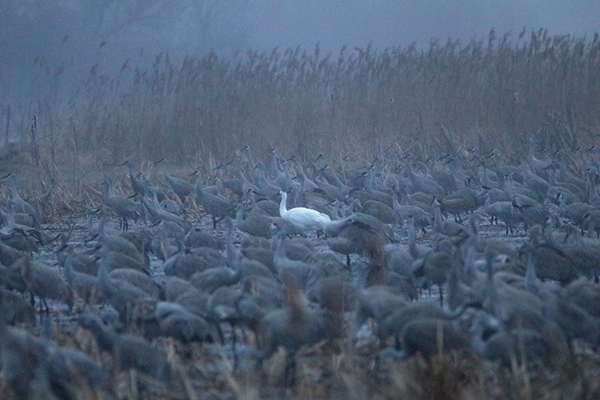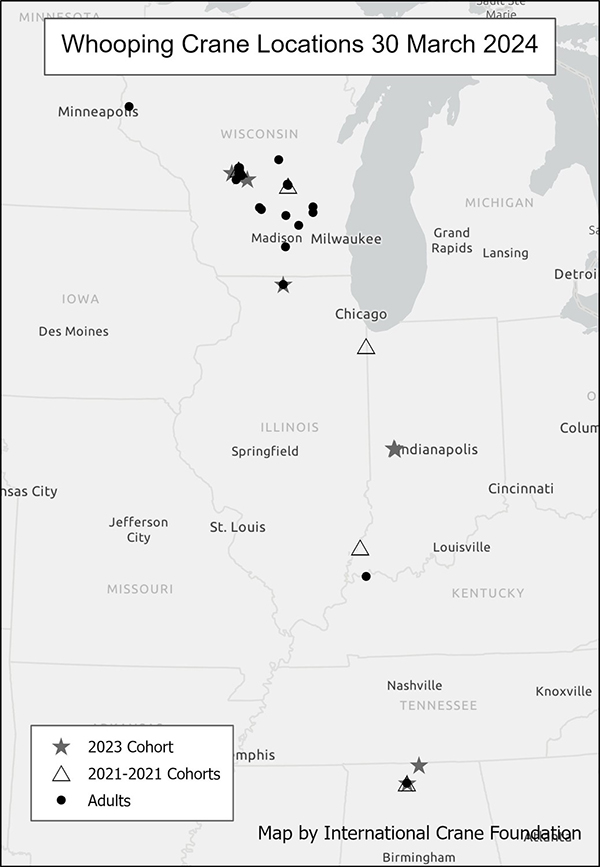
Below is the most recent update for the Eastern Migratory Population of Whooping Cranes. During March, most birds have arrived on their typical breeding/summering grounds in Wisconsin. There are still some cranes migrating back and a few juveniles who have yet to leave their wintering grounds. A huge thank you to the staff of the Fish and Wildlife Service, the Departments of Natural Resources of flyway states, the International Crane Foundation and all the volunteers who help us keep track of the cranes throughout the year. We appreciate your contribution to the recovery of the Whooping Crane Eastern Migratory Population. The International Crane Foundation produced this report.
Population Estimate
The current estimated population size is 72 (40 F, 30 M, 2 U). Fifteen of these 72 individuals are wild-hatched, and the rest are captive-reared. To the best of our knowledge, as of 1 April, there are about 46 in Wisconsin, three in Illinois, five to eight in Indiana, and one to four in Alabama. The remaining birds’ locations have not been confirmed in the last month. Their last known locations (in the past month) are on the map below.

2021 and 2022 Cohorts
W2-21 (M) has returned to White River Marsh State Wildlife in Green Lake County, Wisconsin and seems to be paired with W3-17 (F).
W14-21 (M) has returned to Necedah National Wildlife Refuge in Juneau County, Wisconsin, with W3-20 (F).
84-21 (F) was last seen in Gibson County, Indiana. She was associating with 25-10 (M), but he was observed migrating north without her.
85-21 (M) was last seen around Wheeler National Wildlife Refuge in Morgan County, Alabama, as of early March, associating with 7-11 (F).
W1-22 (U) is in Will County, Illinois.
2023 Cohort
W9-23 (F) is still around Wheeler National Wildlife Refuge in Morgan County, Alabama.
In early March, W12-23 (M) was still with his parents, 24-08 and 13-02, in Madison County, Alabama. His parents have since arrived at Necedah National Wildlife Refuge in Juneau County, Wisconsin, but we have not yet confirmed if W12-23 has returned with them.
W13-23 (U) separated from parents, 12-11 and 5-11, and has been migrating north with 25-10. They were last observed in Winnebago County, Illinois.
15-23 (F) has migrated back to Necedah National Wildlife Refuge in Juneau County, Wisconsin, with 15-11 and W6-18. Upon returning, 15-23 separated from 15-11 and W6-18.
21-23 (M) and 22-23 (F) have migrated back to Necedah National Wildlife Refuge in Juneau County, Wisconsin and are still together.
16-23 (F), 17-23 (F), 19-23 (M), 20-23 (F), and 23-23 (M) are still together in Putnam or Parke County, Indiana.
Mortality and Long-term Missing
None known for March.

Story submitted by Hillary Thompson, North America Program Crane Analyst. Click here to learn more about our work in North America.
